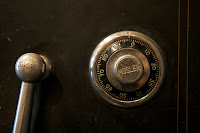It's hard to pick a favorite food from childhood but one of my favorites was Yorkshire pudding. Recently I read that Yorkshire pudding was considered a poor man's dish. Poor man's dish or not, I loved having Yorkshire pudding with Mom's roast smothered in gravy. For some reason, we haven't had it in a number of years, but I do remember having quite a bit of difficulty the first couple of times I tried to make it. Let's just say technology got in the way.
One of the first steps to making Yorkshire pudding, after preheating the oven, is to melt a stick of butter. A simple task, it would seem. The first time I made Yorkshire pudding, I placed the Pyrex dish and the stick of butter in the microwave to melt the butter. It seemed more efficient: melt the butter while the microwave is preheating. For some reason the Yorkshire Pudding just didn't come out right. I mean, it tasted fine, but it was kind of flat. Fortunately, my mother in law, who grew up on a farm and is a brilliant cook, was visiting. She suggested melting the butter the old-fashioned way: by putting the Pyrex dish and the stick of butter into the preheated oven to melt the butter. Problem solved. The pastry rose just fine and tasted great. Just the way I remember it. There is something about the butter in the hot casserole dish, helping to make that pastry rise and turn out just right. I guess there are some things you just can't do with the microwave.
Without further ado, here is Mom's Yorkshire pudding recipe. I modified the instructions slightly to help those of us who think everything can be cooked in a microwave.
7/8 cup (that’s 1 cup less 2 tbsp.) flour
½ tsp salt
2 eggs
½ cup milk
½ cup water
1 stick butter
Preheat oven to 400 degrees.
In a 9 x 11 Pyrex dish, melt stick of butter in the oven. (You need to both melt the butter and get the dish hot.) It helps the pastry to rise.
At the same time:
Mix the flour and salt in a bowl.
In a separate bowl:
Beat 2 eggs
Add milk to the eggs
Add the egg, milk mixture to the dry mix.
Add water
Beat the entire mix well until you have bubbles.
Pour the mixture in the hot Pyrex dish with the melted butter
Bake at 400 degrees for 20 minutes.
Serve with Pot Roast or Swiss Steak and gravy.
The pastry cuts to 8 servings.
As for my favorite dish today I'd have to say it's clam chowder. Manhattan or New England? I haven't figured that out yet. Our family keeps making both and debating.
© 2011, copyright Michelle Goodrum

























